RTA vs. Assembled Cabinets: Which Is Right for Your Project?
Choosing the wrong cabinets can crush your project budget and timeline. This decision impacts everything from shipping logistics to on-site labor, turning a smart buy into a costly mistake.
RTA (Ready-to-Assemble) cabinets are flat-packed for on-site building, while assembled cabinets are factory-built and shipped as solid boxes. The key difference is where assembly happens, which directly affects your total project cost, timeline, and installation risks.
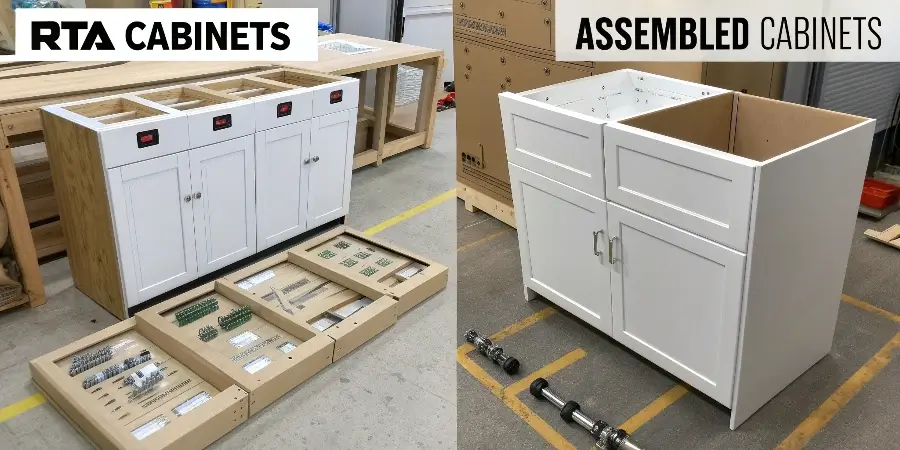
As the CEO of Boke Furniture here in Foshan, this isn’t just a product question for my clients; it’s a critical strategic decision. I’ve worked with many commercial buyers, like Jacky from Canada, who manage large-scale projects. They know that the sticker price of a cabinet is only one part of the equation. The real cost includes shipping, storage, on-site labor, and the risk of delays. Understanding the total picture is the only way to make a truly profitable decision. Let’s break down the key differences to help you choose the right strategy for your next project.
What is the difference between RTA and pre assembled cabinets?
You see two price points but don’t know the real impact of each option. Choosing based on unit price alone can lead to huge, unexpected costs during installation, hurting your bottom line.
RTA cabinets arrive in a flat box, requiring your team to build them. Pre-assembled cabinets arrive as a complete unit, ready to install. This single difference shifts costs and responsibilities between shipping, factory labor, and on-site labor.
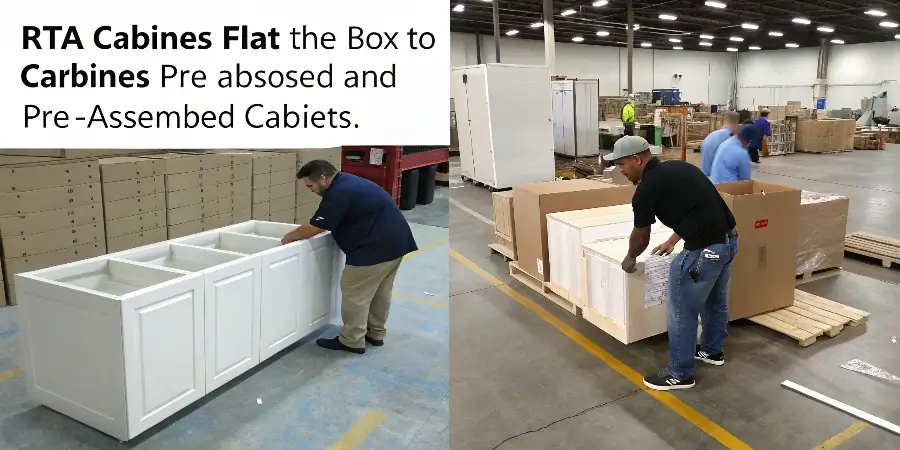
The decision between RTA and pre-assembled is a balancing act of different costs. RTA cabinets have a lower unit price because you are not paying for factory assembly labor. They also cost significantly less to ship because flat-packing is incredibly efficient for container space. But, you must add the cost of skilled on-site labor to build them. Pre-assembled cabinets cost more upfront and take up much more container space. However, they install very quickly on-site, which can save a lot of time and money on labor. This is especially true if your installation crew is expensive or inexperienced. The quality of a factory-assembled cabinet is also more consistent. They are built in a controlled environment with specialized tools and jigs. It is a classic trade-off between logistics costs and installation costs.
| Feature | RTA (Ready-to-Assemble)1 | Pre-Assembled Cabinets2 |
|---|---|---|
| Shipping Cost | Low (flat-packed) | High (takes up more space) |
| Unit Cost | Lower (no factory labor) | Higher (includes factory labor) |
| On-site Labor | High (requires assembly) | Low (ready to install) |
| Quality Control | Depends on installer skill | Consistent factory quality |
| Best For | Projects with skilled labor and tight shipping budgets | Projects with tight timelines and labor constraints |
What does RTA cabinet mean?
You hear the term "RTA" all the time. If you don’t fully understand what it involves, you might miscalculate the time and skills needed for your project, leading to costly surprises.
RTA stands for "Ready-to-Assemble." It means every component of the cabinet is manufactured and finished at the factory, then packed flat for you to build on-site. The box includes all panels, doors, hardware, and instructions.
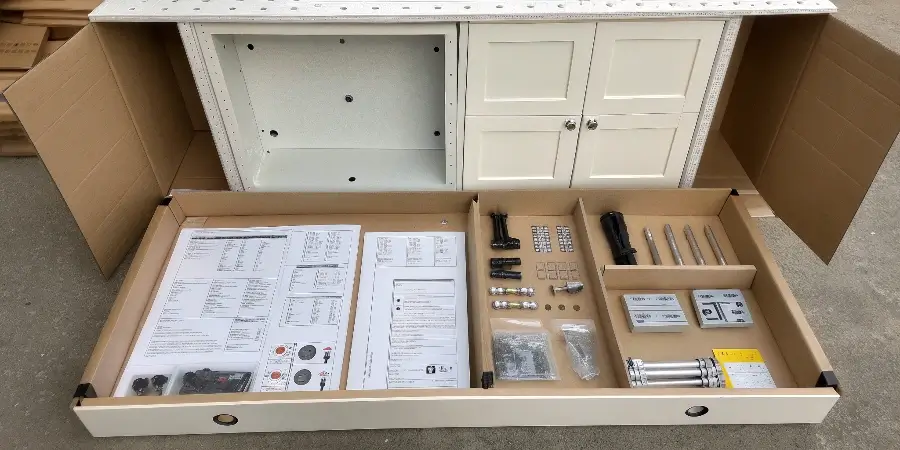
The "Ready-to-Assemble3" concept is important. It does not mean "ready to install." The factory does all the complex manufacturing work. They cut the wood, drill the holes for hardware, finish the doors, and edge-band the panels. Your job is to put these finished pieces together, much like high-end IKEA furniture. The quality of the final product depends heavily on two things: how well the factory prepared the parts and how skilled your installer is. A good manufacturer, like my company Boke Furniture, makes this process easier. We use high-precision CNC machines4 so all parts fit perfectly. We often use cam-lock or similar hardware systems that create strong joints and make assembly faster and more foolproof. Clear, detailed instructions and even video guides are also essential. "RTA" is simply a delivery method, not a statement about quality. You can get very high-quality RTA cabinets made from premium materials.
What are the three types of cabinets?
You’re focused on RTA vs. assembled, but that’s only part of the story. Different construction types exist that deeply affect price, quality, and your options, regardless of how they are delivered.
The three main types of cabinets are stock, semi-custom, and custom. These categories define the level of modification, materials, and size options available, and they apply to both RTA and assembled cabinets.
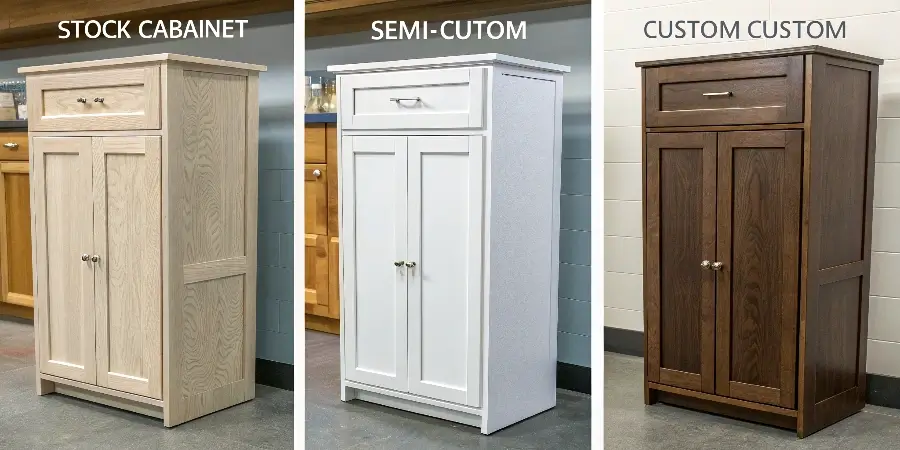
Understanding these three levels is key to smart sourcing. Stock cabinets5 are mass-produced in standard sizes with limited styles and finishes. They are the most affordable and are what most people think of for RTA. Semi-custom cabinets start with a stock cabinet framework but allow for some modifications. You might be able to change the depth or add a special drawer configuration. This gives you more flexibility at a mid-range price. Custom cabinets6 are built from scratch to your exact specifications. You have unlimited choices in size, material, finish, and style. These are the most expensive. The important thing is that these categories are separate from the delivery method. You can order stock cabinets pre-assembled, and you can order some custom cabinets RTA to save on shipping for a large project. For my B2B clients, the choice often depends on the project’s specific needs.
| Cabinet Type | Customization | Price Point | Common Delivery Method |
|---|---|---|---|
| Stock | None | $ | RTA or Assembled |
| Semi-Custom | Some Modifications | $$ | Assembled |
| Custom | Unlimited | $$$ | Assembled |
What is the downside of RTA cabinets?
The low cost and shipping efficiency of RTA cabinets look great on paper. But you worry about the hidden problems. What if assembly becomes a disaster or the quality is not what you expect?
The main downside is the need for skilled on-site assembly, which takes time and labor. Incorrect assembly can lead to a less durable cabinet. Quality can also vary widely between manufacturers, making your supplier selection absolutely critical.
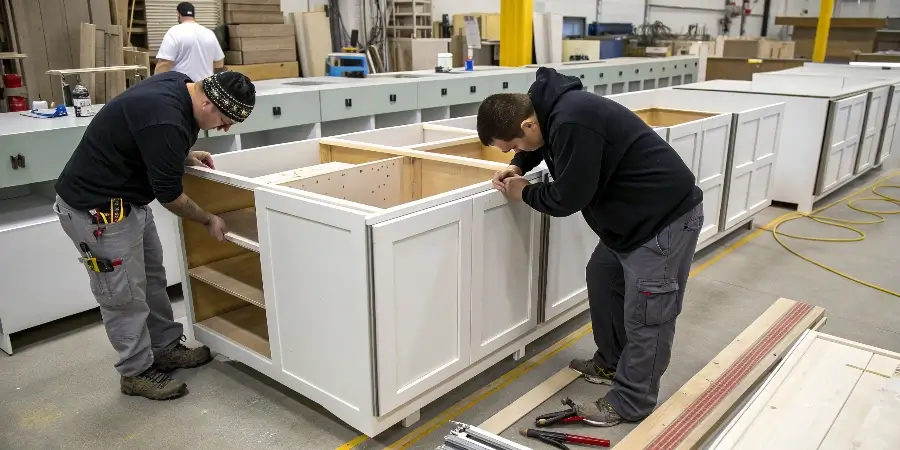
The assembly challenge7 is the biggest risk. You are trading factory labor costs for on-site labor costs. If you lack a skilled, efficient installation team, you can lose all your savings. I have seen projects delayed by weeks because the assembly was slower than planned or done incorrectly, requiring rework. This directly translates to lost money. The second risk is inconsistent quality. Because the final build isn’t done in a controlled factory setting with specialized equipment, the structural integrity depends entirely on the person building it. This is why I often advise large-project buyers to use a "hybrid strategy8." For a big hotel project, order the 200 standard bathroom vanities as RTA to save a fortune on shipping. But for the complex, high-visibility lobby reception desk, order it pre-assembled from the factory. This guarantees a perfect finish where it matters most. Making this a data-driven choice, not just a gut feeling, is how you lower risk and protect your profit.
Conclusion
The best choice is not RTA or assembled. It is a smart strategy that balances total project costs of shipping, materials, and labor to maximize profit and ensure quality.
-
Explore the benefits of RTA cabinets, including cost savings and shipping efficiency, to make an informed decision. ↩
-
Discover the advantages of pre-assembled cabinets, such as quick installation and consistent quality, to optimize your project. ↩
-
Understanding the Ready-to-Assemble concept can help you appreciate the craftsmanship and quality behind RTA furniture. ↩
-
Exploring the role of CNC machines reveals how technology enhances furniture quality and assembly efficiency. ↩
-
Explore this link to understand the advantages of stock cabinets, including affordability and standardization. ↩
-
Learn about custom cabinets to discover their unique features and how they can be tailored to your needs. ↩
-
Understanding the assembly challenge can help you mitigate risks and improve project outcomes. ↩
-
Exploring hybrid strategies can reveal innovative approaches to enhance efficiency and reduce costs in your projects. ↩
